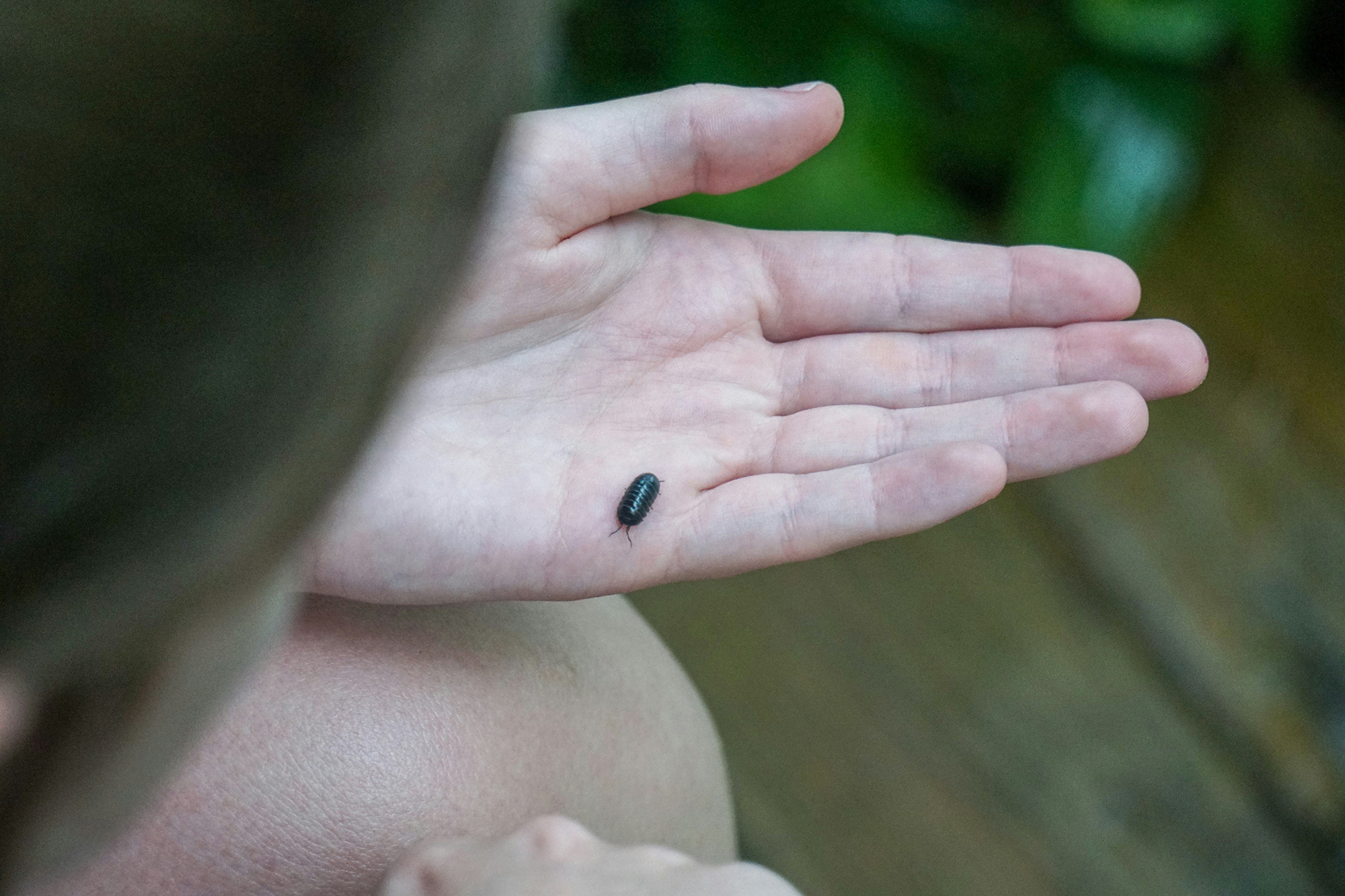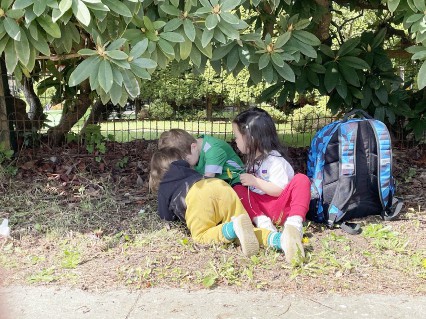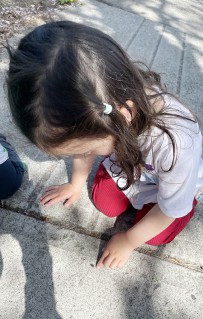
When children explore the world and the more-than-human beings that we share it with, situations can arise that require us as Educators to listen carefully to children's voices, and think deeply about our own assumptions before we engage.
This reflection by Chieri is a beautiful example of what happens when we respect the power of the children's own thoughts and wonderings to shape deep conversations.
On a beautiful sunny day in late April, I went for a walk with C, G, M, and U. During our walk, the children discovered a “jackpot” of roly-poly bugs. At first, they touched and observed the roly-polies by themselves, but soon they began passing them around to their friends. C received a roly-poly in her hand, squealing with delight. As the roly-poly crawled across her palm, it eventually fell to the ground.
C noticed that when it landed, it curled tightly into a ball. Curious, she gently rolled the balled-up roly-poly across the ground with her point finger. After a moment, the roly-poly uncurled and began crawling again. C then pressed it lightly with her finger, causing it to stop moving.
“Chieri, look!” C called, picking up the roly-poly to show me. However, I noticed it was no longer moving, and part of its body appeared to have been lightly crushed.
Chieri: “It’s not moving anymore.”
C: “Why?”
Chieri: “Because we weren’t gentle enough. I think it’s already dead.”
C looked up at me and asked, “What’s ‘dead’?” I paused, struck by the depth of her question.
Chieri: “That’s an interesting question. Yes, what is death?”
C did not respond immediately. Instead, she brought the roly-poly closer to her eyes, studying it intently. She gently touched it with her fingertip, lingering over it. Then she placed it on the ground and continued to interact with it there—softly poking and nudging it, searching for any sign of movement.


At that moment, I was witnessing C’s first introduction to the concept of death. She was examining the lifeless roly-poly, trying to understand what it meant for something to be alive— and no longer alive. This moment reminded me of a question I have asked myself many times since becoming an educator: How should we encourage children to interact with nature, especially with the “quiet living things” like plants and bugs?
We often say, “Be gentle,” when children interact with nature. We are afraid they might be too rough and take a life away from a bug or a plant. Yet, we also know that young children learn through hands-on experience. They are driven to engage actively, directly, and physically with the world around them.
“Much of environmental education today has taken on a museum mentality, where nature is a composed exhibit on the other side of the glass. Children can look at it and study it, but they can’t do anything with it. The message is: Nature is fragile. Look, but don’t touch.” (Sobel, 2012)
Without the roly-poly’s sacrifice, C couldn’t gain the concept of death in that moment. However, we should not treat the life and death of insects as learning materials. The sacrifice was the result of C’s active interactions with roly-poly, but roly-poly was simply there—it wasn’t there for the sake of her learning.
Throughout history, humans have taken the lives of living beings that were there to sustain our existence. We kill animals and eat their meat, use their bones to craft tools, and use their fur to clothe ourselves. Animal oils become fuel; plants are harvested for food, medicine, and shelter. Taking from nature—and giving back—is part of human existence.
Are children, through their exploration, instinctively reenacting this relationship by testing, experimenting, and learning what nature offers?
From my personal experience, I would say that I learned so much through what might be called “rough” play with plants and bugs during my childhood. I grew up in a house with a large garden where we grew vegetables year-round. Bugs and plants were everywhere. The ways I interacted with them were far from gentle—they were often brutal. I picked flowers and leaves and crushed them against rough stones. I caught butterflies, placed them in water, and buried them in sand, pretending to “cook them into fried chicken.”
It sounds awful now, but back then, I was just curious, experimenting. Through these actions, I didn’t just destroy—I discovered. I learned how to extract juice from plants, how to use natural dyes, and even about insect anatomy. I believe that was part of my early education in the blessings and realities of nature.
But what if this human nature—to take from the environment—is at the root of many problems we face today?
Over time, our relationship with nature has shifted. We now know that natural resources are limited. We can no longer take from nature endlessly. And yet, humans continue to exploit and damage ecosystems—sometimes irreversibly.
Is this why we tell children to “be gentle” with living things? Are we trying to teach them that life is fragile—that once lost, it cannot be retrieved?
Is “gentleness” a way of teaching them respect, gratitude, and an understanding of life’s irreversibility? Or can humans learn the value of nature and life only when we lose them?
When we think about the relations between nature and humans, we should not forget that humans have long tended to nature. For example, rather than destroying nature, thinning can be seen as a stewardship approach to the forest, managing it for health and sustainability by reducing competition among trees, improving air circulation and sunlight, promoting biodiversity, and lowering the risk of wildfires. However, if too many trees are cut, it can lead to deforestation, and finding the right balance is not easy.
The relationship between humans and nature is not simple; it is complex and nuanced. However, we can say that because humans receive many gifts from nature, we also have a responsibility to care for it. How can we provide children with opportunities to learn not just about nature, but how to live with it?
What kind of attitude should we have toward children with nature? Should we be open to children interacting physically with nature? Does it mean we ignore the possibilities that children might hurt living things? What other words can we use instead of “be gentle” when children are exploring nature?
Reference
Sobel, D. (2012, July 2). Look, Don’t Touch. Orion Magazine. https://orionmagazine.org/article/look-donttouch1/. (Accessed April 28, 2025).
This article originally appeared in the Summer 2025 issue of the ECEBC Journal.
Chieri Hagimoto is a proud early childhood educator at Frog Hollow Neighbourhood House, with a background as a children’s librarian in Tokyo. She finds joy in witnessing children’s sense of wonder as they explore the world around them.
